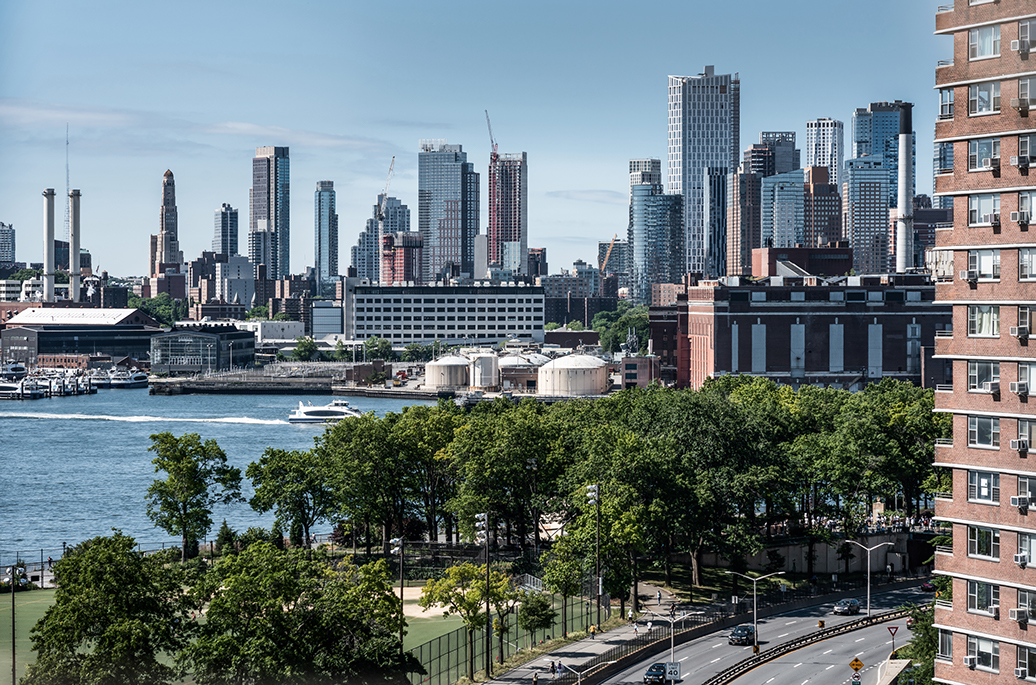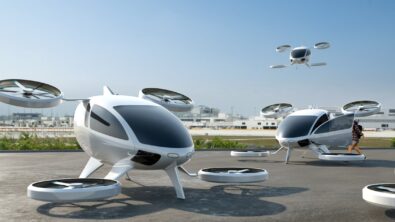Rethinking Infrastructure for AAM Part Three – Transcript

In this episode of Talking Aerospace Today, Todd Tuthill and John Nixon conclude their conversation of building infrastructure for advanced air mobility, highlighting the role of the digital twin in designing vertiports and additional considerations for their energy needs.
Patty Russo: Greetings and welcome to another episode of Talking Aerospace Today from Siemens Digital Industries Software. I’m Patty Russo and I’m responsible for global marketing for the aerospace and defense vertical here at Siemens. Thank you for joining us. We’re glad you’re here. If you haven’t caught the first two episodes on this arc about AAM infrastructure, we invite you to go back and give those a listen. There’s some great insights in those two episodes. Today we’ll conclude our conversation on the challenges related to infrastructure for advanced air mobility. Last time we were joined, of course by Todd Tuthill, who is our Vice President of Aerospace and Defense here at Siemens. And we had John Nixon join us. He’s our Vice President of Energy, Chemicals, and Infrastructure.
Patty Russo: We discussed the requirements and considerations for vertiports, the facilities intended to support AAM vehicles as well as novel ways to power them. I look forward to hearing more on this topic, so let’s dive right in with a question for John. While we’re considering the design of the aircraft and vertiports, John, I’m curious what are some of the insights you can offer for ways that AAM companies could build or improve the development of vertiports specifically to ease the burdens related to, you know, Todd talked a lot about the design, you know, kind of the mechanical stuff, but with respect to easing the burdens related to energy, infrastructure, and of course, serviceability?
John Nixon: Patty, great question. So improving vertiports, you know, easing their energy burdens is crucial for the successful deployment of advanced air mobility infrastructure. I mean, vertiports can be designed with integrated renewable energy systems like we talked about before. You know, micro grids or small modular reactors and so forth. This will reduce their dependence on the central grid. It will enhance their sustainability. Additionally the energy storage systems can store excess energy generated during off peak times for years during peak demand. Incorporating energy efficient design principles, in vertiports can significantly reduce their energy consumption. This includes, you know, like use of energy efficient lighting, heating, ventilation and air conditioning. You know, HVAC systems as well as high-performance building materials that improve insulation and reduce energy loss.
John Nixon: Implementing smart energy management systems can optimize energy use within vertiports. These systems can monitor control energy consumption in real time, ensuring that energy is used efficiently and reducing waste. And, you know, something that’s, you know, you mentioned something, Todd. You mentioned modularity. Well in my world of infrastructure, modular construction is always on the grow globally. In a former life, when I worked on an open pit mine over 85% of all the infrastructure we installed was modular. A great deal of it coming from places as far away as South Korea and India, so it’s incredible how modular construction is, has really started to dominate and it will be very impactful in a positive way for vertiports. And this will ensure that vertiports can be quickly upgraded with new technologies like advanced charging systems or additional renewable energy sources without significant disruptions.
John Nixon: And utilizing, for example, sustainable building practices in the construction of these reports will reduce their environmental impact. You know, a sad fact about construction. It is estimated that 24% of all solid waste produced in the United States comes from the construction industry. So use of recycled materials, green roofs, you know, water efficient landscaping. I mean, the list goes on and on. There are many examples of sustainable practices that vertiports can have to reduce not only their energy consumption, their dependence upon an unreliable grid, but be shining examples of infrastructure that is a positive versus a negative impact on its environmental surroundings.
Patty Russo: Yeah, sustainability and sustainable practices. The buzzwords of the decade, right? And as we talk about developing products, it’s not just about making the products themselves sustainable, but also the processes by which those are developed. The considerations for sustainability also have to be incorporated there. It brings to mind a question, Todd, for you. Where does digital transformation maturity come into play in developing such sustainable solutions and how can solutions for digital transformation help the industry and players in the industry address or head off some of these challenges?
Todd Tuthill: You know, when I think about that in the advanced mobility industry, this is an industry, a small industry trying to get off the ground. It’s got a lot of venture capital support. There are companies that are going to make it, companies that aren’t. The ones that make it, the ones that are going to make the right decisions, before they go out and invest a lot of capital in building infrastructure and building vehicles, and when you think about trying to make the right decisions early, digital transformation maturity gives you the ability to do a lot of what if scenarios or day in the lives, you know, from the and from very different perspectives.
Todd Tuthill: What’s a day in the life of the person who’s going to sit on this vehicle. What’s the day in the life of air traffic control in a large city when you’ve got all these vehicles flying? What’s the day in the life of the maintainer or the person working at the vertiport trying to direct traffic for these things in and out? And there’s a lot of issues and problems that you want to find digitally before you go build a vertiport, before you finish your design and you say, “Gee, I wish I’d had this this feature built into my aircraft.” And digital transformation can really help you find, and digital twins can help you find and understand a lot of those things. And of course there’s a whole aspect of digital transformation that just goes into the overall design of a complex aircraft for advanced air mobility like it would for other aircraft.
Todd Tuthill: And I’ve kind of avoided that a bit because we’re going to talk about that a bit more in our next episode because we talk about things like safety and how, what’s it take to design, safely design an aircraft that’s powered by batteries now as opposed to powered by fossil fuels? Because certainly fossil fuels are, you know, flammable. But we’ve all seen the videos of what happens when somebody’s cell phone catches on fire in the cargo compartment of a 737. Well, imagine I’m sitting on this giant, you know, panel of batteries. What if something happens to those batteries? What do we do? And how do we prevent that? And digital transformation can help address all of those issues, and we’ll talk more about the battery issues in the next podcast. So those are some of my ideas. What do you think, John?
John Nixon: Hey, great question and I love what you’re talking about here. You’re talking about digital transformation. You know, I harkened back to, it was 2015. We had just come off of the second half of the year 2014, where oil had just collapsed in price, and so you had energy companies reeling from that and the CEO of Synovus Energy, Brian Ferguson, was interviewed by Business Insider. And in that he stated, and it just was, it was a clarion call around energy and infrastructure. He made the statement, “We must have a manufacturing mindset when it comes to capital projects.” And you know, translate that. That means he was calling for a digital transformation in our industry. And it’s an incredible tool.
John Nixon: Digital transformation for us, it’s digital twins. It’s creating the physics-informed models of the physical assets like vertiports and air taxis that we’re talking about. These, you may recall the first week of January of this year, Roland Bush was able to get up at the Consumer Electronics Show, and he was discussing the industrial metaverse. So when I talk about, you know, these models that can simulate various scenarios and predict potential issues and optimize operations, that’s not in the future. That’s today. We’re doing that now in energy and infrastructure. That’s why I love working at this place. By using digital twins, advanced air mobility companies, they can design, you know, far more efficient vertiports, planned maintenance proactively, you know, design for service and improve overall system reliability.
John Nixon: And of course advanced data analytics and artificial intelligence, which everybody is talking about today, can analyze vast amounts of data from sensors and connected devices and really help in identifying patterns, in predicting demand and optimizing energy use like we talked about before. And when you have IoT enabled vertiports that can monitor that energy use and environmental conditions and equipment status, it allows for a more immediate response to issues and optimization of those operations and that energy consumption. There is an incredible array of systems that track energy consumption and forecast demand and manage energy storage and distribution.
John Nixon: So the opportunities here to have this industrial metaverse, this physics-informed digital twin around vertiports, we’re seeing that today and it’s truly transformative. I’m seeing it in every other segment of energy and infrastructure and I’m so excited about what it’s going to do even in that first generation of vertiports that you’re talking about, Todd, that are going to be around in the late ‘20s and early ‘30s.
Patty Russo: Yeah. The one word that comes to mind with everything we’ve talked about is complexity from, you know we’ve covered a lot of ground, the global electric grid, sustainability, development of vertiports and considerations in that regard. Modular development practices for AAMs, digital transformation maturity, etc. I wanted to touch on one last question as we reached the end of our podcast. Is there anything that I haven’t prompted either of you that you want to cover before we wrap up this incredibly informative episode about AAM and all the things related to infrastructure?
John Nixon: So Patty, thank you. That’s a great question. A couple of things. First, Todd, as I look at you in this podcast, I’m challenging your industry to think about visual navigation of complexity. That’s what a physics-informed digital twin in this concept that we’re calling the industrial metaverse. That is available today as we develop tomorrow’s vertiports and tomorrow’s infrastructure. So I’m so excited that we’re colleagues and that we’re working together here because we’re putting in place the necessary digitalization that allows for that energy transformation, that allows for that transportation transformation that you’re talking about. And the other thing that I’d like to touch on, I talked about this in my earlier point around where energy intersects infrastructure, and in support of vertiports, right, with our current, you know, near term energy mix and that is we’ve got to have some robust energy storage solutions.
John Nixon: Global energy storage market, it’s expected to grow from 173 GW hours in 2020 to well over 1000 GW hours by 2030. That’s a sixfold increase. This rapid growth, it highlights the crucial role of energy storage in supporting this energy transition and integrating renewable energy sources. We’ve seen modern battery storage systems such as lithium ion, they’ve significantly improved in efficiency and cost, and the cost of utility scale batteries, battery storage has fallen, you know, almost nearly 70% over the past decade. That’s making it a lot more viable for supporting vertiports and air taxi operations as part of that micro grid I talked about.
John Nixon: If you look at, here’s an example, like California, one of the leading states in renewable energy adoption, energy storage systems have played a pivotal role in enhancing that grid stability. The state aims to deploy no less than 1325 megawatts of energy storage by 2025 to support its ambitious renewable energy goals, and this example underscores the importance of energy storage and facilitating the transition to cleaner energy sources. Investing in robust energy storage solutions, it’s essential for supporting the growth of advanced air mobility. And when you leverage the benefits of modern battery storage systems, again, which you can design with the end in mind, with a physics-informed twin in the in what we have to offer, you’ll be able to ensure a reliable, efficient and sustainable power supply for all air taxis, thereby addressing one of the key infrastructure challenges to this industry.
John Nixon: I just wanted to take a moment and I wanted to thank you all for inviting me on the show. It has been an incredible pleasure to discuss these important topics and I don’t know about you, but as I look at the next generation of engineers, the men and women that grew up on Xboxes and PS5s and androids and iPhones, and I look at the technology they have before them that I could have only wished for when I was their age, it is going to be exciting to watch not in decades, but in years the transformation that’s going to occur as we electrify this plan et and we bring things like vertiports to life. Thanks, Todd. Thanks, Patty.
Todd Tuthill: Well, and thank you, John. I can hear the excitement in your voice when you talk about your passion for energy. So I really appreciate you bringing all that passion to this podcast. And I guess, Patty, I’m going to go back to something John said for my one more thing. He talked about energy storage, and he was talking about energy storage and a vertiport and on the grid. I’m going to tease our next episode because that’s where we’re going on this next episode. We’re going to talk about energy storage but on the vehicle itself.
Todd Tuthill: We’re going to get into the physics of batteries, the design of batteries, the whole concept, and the issue I have with the energy density and the physics related to can we pack more stuff, more energy into the size and weight of the batteries we have? How do we do that? And when we do that, what does that do to the design of the aircraft? What does it do to safety and all kinds of cool stuff coming up on our next episode on talking aerospace today about batteries and range in advanced air mobility. So that’s where I’ll end today, and again thank you so much John for joining us today.
Patty Russo: Yeah, perfect note, Todd, to conclude this conversation as always. Thanks to you. And John, thank you for your expertise and enthusiasm for the topic. I hope our listeners and as John mentioned, future engineers are as energized as I am about the future of advanced air mobility in the A&D industry. We appreciate such valuable insights we’ve brought to the table today and thanks to all of our listeners for tuning in. We’ll discuss more challenges faced by the AAM sector in our next episode. I’m Patty Russo and we look forward to seeing you again next time on Talking Aerospace Today.
Siemens Digital Industries Software helps organizations of all sizes digitally transform using software, hardware and services from the Siemens Xcelerator business platform. Siemens’ software and the comprehensive digital twin enable companies to optimize their design, engineering and manufacturing processes to turn today’s ideas into the sustainable products of the future. From chips to entire systems, from product to process, across all industries. Siemens Digital Industries Software – Accelerating transformation.


